

Lebanon has long been a crossroad of civilizations and a mosaic of cultural heritage. With a history of tourism that dates back to the Phoenician times, Lebanon has always been a country that charmed travelers with its diverse landscapes, historic sites, and rich culture. From the cosmopolitan vibe of Beirut to the serenity of its mountainous villages, Lebanon offers an array of experiences for the avid explorer.
Lebanon's modern tourism industry began to flourish in the 1950s and 1960s, when it was known as the "Switzerland of the East". International travelers and regional tourists flocked to experience its vibrant nightlife, cultural scenes, and the natural beauty of its beaches and mountains. The Lebanese civil war from 1975 to 1990 put a significant halt to tourism, but since the turn of the century, the industry has been on a steady path of recovery.
Despite setbacks due to political unrest and occasional conflicts, Lebanon’s tourism sector has shown remarkable resilience. In recent years, there has been a growing trend toward sustainable tourism and an emphasis on preserving Lebanon's natural landscapes, historical sites, and cultural heritage.
Nestled within the sacred Qadisha Valley, named a UNESCO World Heritage Site along with the nearby Forest of the Cedars of God, the Qadisha Grotto is a testament to Lebanon's natural beauty. The grotto, also known as the Afqa Grotto, is a wondrous cave network located at the source of the Iblish River.
The grotto has been a destination for those drawn by the allure of its subterranean wonders. Visitors can explore its limestone caverns which are home to stunning stalactite and stalagmite formations. The grotto is also of significant ecological importance due to its diverse biosphere of local flora and fauna.
The Cedars of God, which are among the last survivors of the extensive forests of the Lebanon cedar trees that once thrived across Mount Lebanon, have stood as silent witnesses to the eons. These ancient trees hold great historical significance, often mentioned in various religious texts, and have been a source of pride for the Lebanese people.
Generations of travelers have made the pilgrimage to see these majestic trees. Over time, conservation efforts have intensified to protect and nurture these natural wonders, ensuring they remain a testament to Lebanon's enduring natural heritage.
In recent years, Lebanon has seen a rise in eco-tourism and adventure tourism. This shift has been driven by both global trends and Lebanon’s efforts to diversify its tourist offerings to cater to a broader audience. Some of the latest trends in Lebanon’s tourism include:
Lebanon continues to be a destination that combines the allure of its ancient past with the prospects of a vibrant, modern tourist experience. Qadisha Grotto and the Cedars of God remain timeless attractions, deeply rooted in the country's historical and natural legacy, embodying the enduring spirit of Lebanese tourism.